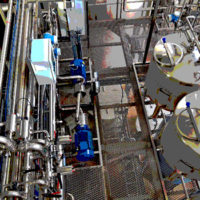Food Safety at the Heart of Rice Processing

An interview with Bühler’s Food Safety Initiative team reveals how designing safety into every aspect of rice production is vital for each player in the supply chain and how Hazard Analysis and Critical Control Points (HACCP) and optimized equipment design can support the industry in achieving safe, high-quality product that meets regulatory and consumer expectations.
What is driving the need for food safety and hygiene today?
Rustom Mistry, director, sortex & rice – Bühler Group China and Southeast Asia: Consumers are becoming more and more conscious of the safety of their food supply and becoming increasingly demanding. Foodborne illnesses are the result of consuming contaminated foods, and rice, like any other crop, is at risk of contamination from many quarters. Ultimately, food quality goes hand in hand with food safety.
With supply chains becoming more complex, and the demand for rice rocketing, rice millers are forced to face the implications of producing contaminated product and are becoming more vigilant about safety. For some time, the need to fulfil the requirements of certification and third-party auditing meant that it was only exporters that faced the challenges of food safety. However, as domestic and international food regulation agencies have put ever greater emphasis on food safety, this issue has begun to spread inexorably onto the agenda for local rice producers as well.
What aspects of food safety are causing the greatest concern, and what contaminants are most prevalent in rice?
Béatrice Conde-Petit, senior expert food science & technology: Similar safety concerns prevail throughout the supply chain and reflect the need for attention to food safety at every stage of production. Contaminants that can enter rice include agricultural or processing chemicals, ranging from insecticides to factory lubricants. There can be foreign materials, such as glass, metal, sticks and unwanted grains. In addition, the rice might be contaminated with insects, molds, mycotoxins or bacteria.
Critically, consumers nowadays lack inherent trust in their food supply and are anxious about the presence of these contaminants, particularly insects, heavy metals and processing adulterants, as well as unsound grains that will spoil their dishes.
Meanwhile, food safety for rice millers means addressing pest infestation that can lead to losses in storage, spoilage of rice due to molds and harmful bacteria, the removal of unsound grains and contamination with mycotoxins such as aflatoxin or by heavy metals. They must also manage the cleaning and disinfection of their equipment.
Significantly, in premium markets, processors of branded and further processed rice must also meet ever more stringent regulatory requirements, including those regarding the heavy metal content and levels of mycotoxin in rice. They need to comply with retailer audits of hygiene standards, so they need equipment that is designed for hygiene and is easy to clean. They must be able to eradicate pests and reduce the potential for post-processing infection by Bacillus cereus, while using fewer and fewer chemicals.
These concerns reflect the breadth of risks affecting the production of safe, high quality rice.
What can be done to address these concerns?
Mistry: Bühler has long partnered with rice processors globally in the production of high-quality rice products. Critically, however, beautiful shiny rice does not guarantee food safety, and careful attention is needed at every step of production in order to assess and eliminate the risks at each stage.
For rice processors, a formal food safety management system, supported by a HACCP program, is fundamental to ensuring food safety and integrity of the end product. Interestingly, regulators are increasingly looking to HACCP as a mandatory requirement for all food processors and handlers.
What is involved in the HACCP program?
Mistry: HACCP involves conducting a Hazard Analysis, that is, assessing the contamination potential for each step of the production process and identifying measures to prevent or reduce the contamination or ‘hazard.’ Processing points where there is significant risk of contamination are determined as CCPs. Critical limits need to be established for these, together with the corrective actions required to eliminate or control the hazard/contamination, if it arises. Once the process is assessed, CCPs identified and the corrective actions established, processors can set up systems to monitor each CCP and maintain a record of the results of their monitoring. Verification procedures must be put in place that allow processors to monitor that their HACCP system is working well; and all documentation of sanitation logs, supplier agreements, shipping documents retained, to allow cross-reference against any contamination that may arise.
Although HACCP cannot completely eliminate the risk of a hazard entering the rice product, it certainly helps to decrease the possibility to more acceptable levels. As the old adage goes ‘without monitoring and measurement, it is impossible to control a process,’ and HACCP, when effectively deployed—and, importantly, continuously reviewed and improved—goes a long way to bringing the risk of contamination down to acceptable levels.
What other elements help processors achieve greater safety and hygiene in plant?
Mistry: The design of a plant and its equipment plays a fundamental role in preventing potential contamination.
If designed with clear zoning and pre-determined space for operation, maintenance and the movement of personnel, a plant will already be one step ahead in terms of providing an environment that fosters hygienic production. A plant’s structure, as well as the conduits for its utility supplies also need to be constructed with sanitation in mind; and, critically, today’s plants must operate ‘dust free’ at all times, as areas where dust or rice particles can collect represent areas with significant potential for contamination. Therefore, all equipment and accessories, such as bins and hoppers, must be designed to reduce the risk of dust build-up.
What does well-designed equipment and plant involve?
Mistry: Ease and speed of cleaning is vital; coupled with the avoidance of any crevices or hard edges on the housing or internally that can allow dust to accumulate. Bühler equipment features easy access through easily removable machine covers and screens, etc. that are simple and quick to change, and sealing systems that prevent any dust leaking out into the plant. The equipment is designed to be either well sealed to the floor or clear of the floor, to ensure thorough cleaning at the base of the machine.
The plant should be designed to have an ‘airlock entry,’ to avoid dust coming into the plant, and have smooth flooring, sealed and rounded off where it meets the walls, to avoid crevices where dust can built-up. Critically, a well-designed aspiration system must be built into every modern plant seeking to meet today’s stringent standards of good product quality, sanitation and hygiene. Any aspiration system must be engineered well, in order to meet the stringent criteria necessary to achieve a ‘dust-free’ plant.
What particular advantages does Bühler equipment bring?
Mistry: Bühler’s state-of-the-art rice processing solutions are designed for continuous and trouble-free operation: carefully designed and calculated on paper, prior to installation, to ensure efficient and rapid fulfilment from order to commissioning. Every element of design is tailored to the highest international safety and hygiene standards, including the optimum design of aspiration and spouting systems, as well as built-in space for operation and maintenance around each machine.
Raymond Herbert, patent and regulatory specialist: Peace of mind is a crucial element of Bühler’s offerings. All our solutions meet and invariably exceed customer expectations and the European Commission’s Machinery Directive, which dictates that all processing machinery is safe and contributes to the prevention of contamination. We provide certification for all our machines to support rice processors in achieving their own compliance and HACCP fulfilment,, as all materials that come into contact with the food stream are required to have suitable documentation, to prove they are safe for food contact.
Plastics are particularly subject to stringent controls, when used in food contact areas, and increasing awareness of the potential for constituent materials used in plastics being absorbed by food, particularly by fatty or acidic food products, mean that stringent controls now apply to their use. The controlled use of plastics and stainless steel components, which prevent entrapment of product in recesses or voids, is an inherent part of the design of each and every piece of Bühler equipment, which is supplied with full instructions and advice on cleaning methods and materials, cleaning intervals and maintenance. We have even carried out in-depth surveys to examine the dust emissions during sorting and can provide rice processors with a validated report to illustrate the minute levels of dust present around a Bühler machine, when sorting grain.
Mistry: Flexibility for the future is incorporated into Bühler’s design. Automation brings less downtime and more effective production uptime, while higher yields and lower power consumption costs are possible, thanks to cutting edge technology and Bühler’s extensive engineering expertise. Excellent design and good automation ensures immediate start-up with no choking in plant. Pneumatic slide gates automatically close following power cuts, preventing the machine from crushing product during the restart, thus reducing broken product and increasing yield. Ultimately, Bühler understands and embraces the sanitation requirements of a modern, dust-free plant that meets the need of international standards and maintains its aesthetic appeal, making the plant an enjoyable environment to work in and a source of pride for mill owners and personnel alike, for decades to come.
Bühler’s offering is far greater than machinery though, can you say more?
Conde-Petit: Bühler and the company’s food safety initiative can support processors at every step of the way, towards achieving the ultimate in safe and high quality end product, through consultancy and advice, as well as the highest quality hygienic solutions.
We can advise customers on how to control mycotoxin levels. For instance, we can provide details of how losses due to pests or the formation of mycotoxin can be cut through appropriate drying and storage. We are also building our knowledge around heavy metal contamination and methods for controlling them. Bühler’s state-of-the-art grain sorting capabilities can be used to remove contaminants, such as insects, sticks, metal and other grains for example, to help achieve not only the highest-quality end product, but also a safer end product.
Drawing on our 150 years’ experience, we offer consultancy support to rice processors, looking to achieve the optimum factory design that encompasses efficiency, quality and safety throughout.
Where is Bühler’s expertise already bringing benefits to rice processors?
Mistry: We have already installed processing plants throughout the world to support rice processors in meeting today’s stringent safety and hygiene requirements.
In the U.S., Bühler worked with the largest mill in California, on a 75 t/h facility that transforms paddy to white rice, 24 hours a day, with the minimum risk of contamination. In India, the most important exporter of first class basmati and other rice varieties turned to Bühler to create the ideal layout of its multi-floor system, with low operating costs, giving maximum yield, with low breakages, at a rate of 20 t/h.
Other installations include a fully automated plant, which increased the capacity and lowered operating costs for Thailand’s number one rice exporter of first-class quality rice, a 40 t/h paddy to white rice production process in China and a specially developed Pneumatic RiceLift for the pneumatic conveying of Japonica rice in Japan. The RiceLift gives flexible, residue free conveying, eliminates grain breakage, and helps Japanese processors fulfil on the high standards of traceability, sanitation and HACCP they require.
What does the future hold?
Mistry: Rice processing plants in future will inevitably move from manual operation to industrialized and automated plants, based on both single and multi-level floor concepts, capable of processing multiple different rice varieties. They will feature the ultimate in product safety and hygiene, tracking product, to ensure that the end consumers feel safe about the food they buy. Currently, this is critical to exporters, but will also affect domestic producers, in the longer term. Food safety has been a topic that has been addressed for a long time in the food industry and will now be enforced in many rice-exporting countries, as the basic prerequisite for export. Bühler, with its international and worldwide expertise and global presence, with local understanding of each market is ready to serve the industry to make a step-change in the field of safe and hygienic rice processing.
Bühler is a global leader in the field of process engineering, in particular production technologies and services for making foods and advanced materials. Bühler operates in over 140 countries.
Looking for a reprint of this article?
From high-res PDFs to custom plaques, order your copy today!





